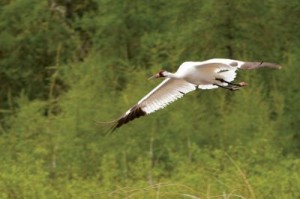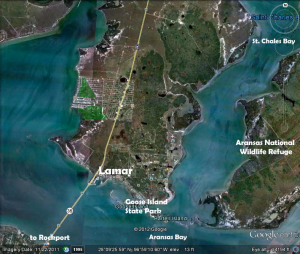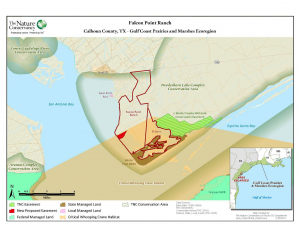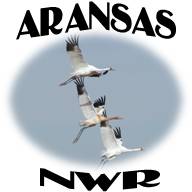Archive for June 25, 2012
Remote Tracking of Aransas-Wood Buffalo Whooping Cranes
June 25, 2012by: Chester McConnell, WCCA
Several government agencies and private organizations have formed the Whooping Crane Tracking Partnership (WCTP) to determine, more specifically, the migration path and activities of whooping cranes that migrate between Aransas National Wildlife Refuge, Texas and Wood Buffalo National Park, Canada. The WCTP trapped whooping cranes, made health checks and collected blood and other biological samples. Then they placed on each crane a Global Positioning System with Platform Transmitting Terminals device as a way to identify migration pathways for the Aransas-Wood Buffalo whooping cranes. WCTP recently released a report covering the 2011 breeding season and fall migration.
The WCTP gathered detailed information concerning where 23 whooping cranes spent time at and the length of time they remained at various locations during the 2011 breeding season and fall migration. Highlight from the report described one adult crane nesting during the summer 2011 but was observed without young during fall migration. Tracking data showed one 1-year- crane spending the summer in southern Saskatchewan and northern North Dakota.
Migration travel time between the Wood Buffalo summer nesting area in Canada and the wintering habitat at Aransas, Texas varied for different whooping cranes. Some of the 23 cranes with GPS were migrating during a 79 day period. The first cranes began migration on September 10 and all cranes that completed migration arrived on the Texas coast by November 27.
Mortality during migration is important to understand. The WCTP confirmed one mortality of the 23 GPS whooping cranes during migration. This was a juvenile crane that died in early November. WCTP plans future trapping efforts for August 2012 at Wood Buffalo National Park and during winter at Aransas National Wildlife Refuge. Hopefully the study will help to better understand whooping cranes and management needs. The report includes much interesting information.
The entire WCTP report with a map can be read by clicking on the following link: http://www.cranetrust.org/wp-content/uploads/2012/06/Whooping-Crane-Tracking-Partnership-2011-breeding-and-fall-update.pdf
Man Indicted For Killing Whooping Crane and Witness Tampering in South Dakota
June 18, 2012June 18, 2012
United States Attorney Brendan V. Johnson announced that a Miller, South Dakota, man has been indicted by a federal grand jury for Violating the Migratory Bird Treaty Act and Witness Tampering.
Jeff G. Blachford (Facebook Profile), age 25, was indicted by a federal grand jury on June 12, 2012. He appeared before United States Magistrate Judge Mark A. Moreno on June 15, 2012, and pled not guilty to the indictment. The maximum penalty upon conviction is 20 years’ custody, a $250,000 fine, or both; not more than 3 years of supervised release; and a $100 special assessment. Restitution may also be ordered.
The charges relate to allegations that in April 2012, Blachford shot and killed an endangered whooping crane and one hawk in Hand County, approximately 17 miles southwest of Miller, South Dakota. Blachford is further alleged to have corruptly persuaded a witness to withhold information from law enforcement officials. The charges are merely accusations, and Blachford is presumed innocent until and unless proven guilty.
Whooping cranes are one of the rarest birds in the world with a total population of approximately 600 individuals. The whooping crane killed in this investigation was one of about 300 endangered cranes that migrate from wintering grounds along the gulf coast of Texas to the Woods Buffalo State Park located in Alberta and the Northwest Territories of Canada. This population of whooping cranes is the only self-sustaining population in the world.
The investigation is being conducted by the U.S. Fish and Wildlife Services and South Dakota Game Fish and Parks. The case is being prosecuted by Assistant United States Attorney Meghan N. Dilges. Blachford was released on bond pending trial.
The Whooping Crane Conservation Association is very pleased with the indictment by the federal grand jury. However, the Association cautions that the case must still be brought to trial and a conviction made before justice is served. The Association has a $10,000 Reward for the “conviction” of the person(s) responsible for the senseless killing of the whooping crane. Contributions to the Reward Fund are stil needed. The public is urged to donate to the fund to help convict this and other whooper killings.
Donations (which are tax-deductible) are being requested for the Whooping Crane Conservation Association’s Reward Account. The public is encouraged to donate to this fund. Donations should be mailed to Whooping Crane Conservation Association, 2139 Kennedy Avenue, Loveland, CO, USA 80538 or to donate by credit card click on the link: https://whoopingcrane.com/whooping-crane-shot-10000-reward/
Lobstick Whooping Crane Feared Shot In South Dakota
June 7, 2012Article from Northern Journal, Fort Smith, NT Canada (www.srj.ca).
By CHRIS TALBOT, Northern Journal Reporter, • Tue, Jun 05, 2012

Fort Smith local Ronnie Schaefer believes the whooping crane (like the one pictured here) shot in South Dakota was one of the famous Lobstick pair. (Photo: Klaus Nigge)
A whooping crane recently shot in South Dakota may be one of the famous Lobstick cranes that nest north of Wood Buffalo National Park, according to a Fort Smith man. Ronnie Schaefer, who has observed the cranes for many years, told Northern Journal he believes the crane shot en route to Canada is one of the Lobstick pair. The pair has made the Fox Hole prairie on Salt River First Nation land home for 19 years, usually arriving in the first two weeks of May. They have not arrived yet.
Another reason Schaefer believes it may be one of the Lobstick birds is because they are not tagged. Although not confirmed, it is believed by Parks Canada that the crane shot in South Dakota was likewise not tagged. Schaefer said he is trying to clarify that, but so far, the U.S. Fish and Wildlife Service (FWS), which is investigating the shooting, has been tight-lipped about the case.
Brad Merrill, a spokesperson for FWS Mountain-Prairie Region, said it is FWS policy not to discuss cases still under investigation. He did confirm that the crane was travelling with another adult and a juvenile, both of which were seen in the same corn field where the shooting occurred. What happened to the other cranes is unknown.
“It’s a big loss for us because they’re a recognized pair from here to Aransas,” Schaefer said.
The Fox Hole prairie is the traditional nesting ground for another pair of whooping cranes, which Schaefer said has already arrived and settled in. A new nesting pair has also settled in the area, but Schaefer noted it is not the Lobstick pair.
Others believe it is too early to tell for sure if the killed bird was indeed one of the famous cranes.
“That would be really tough to deduce based on what we know,” Dan Alonzo, refuge manager at Aransas National Wildlife Refuge, told The Journal.
Chester McConnell, trustee emeritus at the Whooping Crane Conservation Association, told The Journal it would be a great loss should the shot crane be one of the Lobstick pair.
“It would be, but I’m not certain (Schaefer) would be correct on that. I don’t know what information he has, but the cranes haven’t been long settling in and some of them would take a little while to settle into nesting,” McConnell said.
According to McConnell, whooping cranes do not all fly in and start building nests right away. Though their time to nest is short, they are known to “fool around.”
With only about 300 whooping cranes migrating between Wood Buffalo National Park and Aransas National Wildlife Refuge in Texas, the loss of any of the endangered birds is significant, Alonzo said. There are approximately 500 whooping cranes left in the world.
“It would be the equivalent to the loss of any other bird,” Alonzo said. “Any loss is significant. We want to do anything to deter that. The Lobstick or any other pair is just as important.”
One death of many
The shooting of the whooping crane in South Dakota is the latest in a dozen confirmed shootings of the species since 1951. Approximately 80 whooping cranes of the western migratory flock have also gone missing during that time, their fates unknown, McConnell said.
Cranes that do not die of natural causes are most likely to be killed flying into power lines or electrified fences, he said, but some people shoot the birds out of malice.
The eastern migratory and non-migratory Louisiana populations suffer even more from human predation. McConnell noted 11 cranes in the eastern and Louisiana populations have been shot in the last two years. Many of those cases are still unsolved. The most recent incident prior to the April 20 shooting in South Dakota was the January 2012 shooting of a male whooping crane in Knox County, Indiana. The crane was spotlighted and shot, according to FWS. Charges are pending against two men in their early twenties.
————————————————————————————————————————
The Whooping Crane Conservation Association has established a REWARD fund to raise $10,000 for conviction of the killer of the whooping crane in South Dakota on May 20, 2012. Donations are still needed. Click on the following link to read details of the Reward fund and how you can help: https://whoopingcrane.com/whooping-crane-shot-10000-reward/
Critical Whooping Crane Wintering Grounds Purchased
June 2, 2012by Whooping Crane Conservation Association
Endangered whooping cranes now have an additional 278 acres of habitat on which they can live during winter. The 278 acres involved two critical habitat acquisition projects for North America’s last wild flock of migratory whooping cranes. In one project, three conservation groups partnered to purchase the privately-owned 178 acres in Holiday Beach area north of Rockport, Texas. Sale of the property closed last week. The endangered whooping crane flock spends the winter in the area and some have often been observed on this property. This important property purchase was coordinated by Coastal Bend Bays & Estuaries Program, Whooping Crane Conservation Association and Texas Parks and Wildlife Department.
Whooping Crane Conservation Association President Lorne Scott explained that wintering habitat in Texas is more confined and threatened than the Canadian breeding grounds. He also said, “The wintering habitat is so scarce and so unavailable, anything that does come up for sale and has potential, we try to secure it.”
Scott stated that the whooping crane has become a symbol of wildlife conservation in North America. He counseled that, “The whooping crane saga has shown that after decades of work and partnerships, we can save a species and work for conservation.” Scott believes, “We have an obligation to make every effort to secure all our native flora and fauna.”
Coastal Bend Bays & Estuaries Program received the funds for the important 178 acre purchase through the U.S. Fish and Wildlife Service’s Endangered Species Recovery Land Acquisition Grant Program, administered by the Texas Parks and Wildlife Department. Matching funds were provided by the Whooping Crane Conservation Association. The Nature Conservancy assisted in the property purchase. CBBEP property manager Jake Herring said “The acquisition of this property is important to CBBEP because it is occupied whooping crane habitat.”
In a second project, The Nature Conservancy made known the protection of more than 100 additional acres of whooping crane winter habitat. With funding assistance from Whooping Crane Conservation Association and U.S. Fish and Wildlife Service, the Conservancy purchased a conservation easement on Falcon Point Ranch in Calhoun County, Texas. The Conservancy purchased the conservation easement for $605,000 with funding from the United States Fish and Wildlife Service, a $200,000 grant from the Whooping Crane Conservation Association and funds from private donors and foundations.
Falcon Point Ranch is located in a coastal region known as Welder Flats.
Whooping crane habitat Falcon Point Ranch, Texas
Today scientists estimate that at least 10 percent of the remaining flock (approximately 25 – 30 birds) winters here. The topography of the property and its waterfront views on San Antonio Bay made it a prime target for development.
“The owners of Falcon Point Ranch have been working to conserve this property for more than five years,” said Bill Ball a representative of the ranch. “It is very exciting to see this important project come to fruition and to know that this truly special place will be protected.”
Ecologists worried that the development of the ranch would not only compromise important habitat on the property, it would compromise surrounding conservation lands as well, including properties the Natural Resources Conservation Service (NRCS) division of the USDA has protected within the last three years.
“NRCS is proud to be a part of this regional effort to protect and restore vital Texas wetlands, for not just the incredibly rare whooping crane but all wetland wildlife species,” said Claude Ross, NRCS Program Manager. “Working with the local landowners, NRCS has worked to protect and restore more than 11,000 acres of habitat in Welder Flats. The Nature Conservancy’s easement on Falcon Point Ranch will help safeguard those investments.”
“Limited and threatened wintering habitat on the Gulf Coast is one of the greatest challenges facing North America’s tallest birds, said Lorne Scott, president of Whooping Crane Conservation Association. “The WCCA congratulates The Nature Conservancy for leading efforts in securing the Falcon Point Ranch.”
The whooping crane population, which breeds in Canada and then migrates 2,400 miles south to the Texas Gulf Coast, declined from an estimated 1500 to just 15 birds between 1850 and 1945. Since then, cooperative conservation efforts between the U.S. and Canada have increased the population twentyfold. Today there are an estimated 300 wild cranes in North America that migrate between Aransas National Wildlife Refuge in Texas to Wood Buffalo National Park, Canada.
“North America all but lost one of its most iconic species,” said Laura Huffman, state director of The Nature Conservancy in Texas. “Although the whooping crane is slowly rebounding, it is still a precarious situation given our state’s growing water challenges and projected growth. If we want our children and grandchildren to experience this majestic creature, conservation efforts to safeguard its habitat aren’t just important, they are absolutely essential.”
The properties now-protected by these two projects will provide important additional winter habitat for the endangered whooping cranes.



